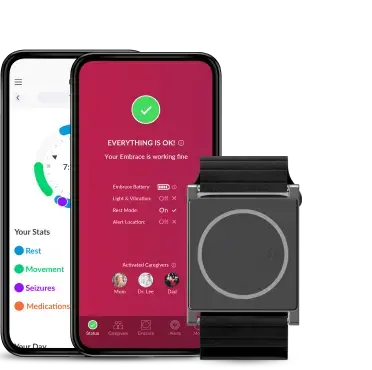SUDEP: What is it and why is it important?
October 23… what does this day mean to you? October 23 may not be the most well-known awareness day, so we hope to shed some light on this important date.
October 23 is SUDEP Action Day.
What is SUDEP, you may ask? SUDEP is the leading cause of death in people who have epilepsy. It stands for Sudden Unexpected Death in Epilepsy [1].
SUDEP is the second highest, of all neurological causes, of total years of potential life lost in the USA. The leading cause is stroke. This value is calculated by multiplying the number of deaths by the estimated number of years left to live, so if someone dies quite young, the number increases. So, how many years of life are lost annually to SUDEP? 101,000 years [2].
Unfortunately, you may have heard about it this summer when actor Cameron Boyce lost his life to SUDEP [3].
This can be a tough thing to talk about. It can be scary, and it may make you upset or sad [4]. However, by discussing it, we may help prevent more of it from happening. This is also the topic that drove the research of our co-founder, Rosalind Picard, as she explained in her TED talk, describing the SUDEP case of a 4-year old boy after he'd apparently just received his epilepsy diagnosis and before his family was ever told of any risk of death.
As the old phrase goes, “Knowledge is power”, so having more knowledge could help you to understand what risk factors apply to you and how to reduce them, so you feel in better control [4]. It can also help you decide what questions to ask your doctor to begin having this important conversation.
Let’s get started.
Again, what is SUDEP?
SUDEP happens when someone with epilepsy dies for no clear, obvious reason (e.g. not from drowning, or anything an autopsy can find). It is unexpected because there was no accident or seizure emergency like status epilepticus. SUDEP may occur after someone has a seizure, but this is not always the case [5].
How common is SUDEP?
Every year, on average, about 1 in 1000 people with epilepsy die from SUDEP, and it is the leading cause of death for people with uncontrolled seizures [5]. Deaths related to it are thought to be potentially avoidable [4]. Risk rates vary: on the high end when epilepsy begins in early childhood and seizures continue throughout someone’s lifespan, the average cumulative risk of SUDEP rises to about 8% by age 70 [6].
This may not seem very common, but let’s consider the situation in the USA. In the USA alone, there are 3.4 million people with epilepsy, including 300,000 children under the age of 14. One-fourth of all people with epilepsy have generalized tonic-clonic seizures (grand mal), which we will see later, are the kinds of seizures most commonly associated with SUDEP [7].
What causes SUDEP?
When cases of SUDEP have been observed (for example in an Epilepsy Monitoring Unit (EMU) with monitoring equipment for the brain, heart, and breathing), they usually occurred in the minutes after a seizure appeared to have ended. We still don’t know the exact cause, but there are some possible factors, as explained by the Centers for Disease Control and Prevention (CDC): [8]
- Breathing: Most SUDEP cases that were observed started after a generalized tonic-clonic seizure ended: in the minutes following the seizure, the person’s breathing became abnormal and then paused. If a pause in breathing lasts too long, the level of oxygen in the blood can be reduced to a life-threatening level, and then the heart can stop beating. Also, because of a seizure, a person’s airway could be covered or blocked and cause suffocation.
- Heart Rhythm: In rare cases, a seizure may cause a dangerous heart rhythm or even heart failure.
- Other causes and mixed causes: SUDEP may happen due to more than one cause or a combination involving both a breathing difficulty and an abnormal heart rhythm [8].
Who is at risk?
As we just mentioned, scientists do not yet know the exact cause of all SUDEP cases, but it could be more common in certain people.
According to the Epilepsy Society, it may happen more often for those who have uncontrolled or poorly controlled seizures. It may also be more common in people that have frequent seizures, especially convulsive ones, compared to those who don’t have convulsive seizures, or who have less frequent seizures.
The risk of SUDEP changes from person to person, but some of the risks surrounding SUDEP can be reduced [4].
How can I reduce my risk?
The best way to prevent SUDEP is to have as few seizures as possible, according to the Epilepsy Foundation [5]. However, a recent publication showed that there have been some cases of SUDEP even for people who had been seizure-free for more than a year [9].
So what can you do? The Epilepsy Foundation suggests the following 5 tips:[5]
- Get the best seizure control possible. This could be by taking your medicine regularly and at the right dose. This is called being “medication adherent”. See your doctor or healthcare team regularly, especially if your seizures are not controlled.If medicines are not working, you could discuss other options like epilepsy surgery, devices, or diet therapy with your doctor.
- Take good care of yourself or your loved one. Make sure that you are eating a healthy diet, sleeping enough, getting regular exercise, avoiding excessive alcohol or the use of recreational drugs, and trying to reduce stress.
- Know and avoid any potential seizure triggers, if you can. Try to keep a record of things that happened before a seizure (such as illness, tiredness, stress, missing medications, and where and when the seizure occurred) [5]. Our seizure diary Mate could be especially useful to keep track of your seizures.
- Talk to your doctor about having your heart checked (cardiac evaluation) to make sure that you don’t have any heart problems. This is especially important for people with uncontrolled epilepsy who don’t have a cause for their epilepsy found on an MRI or another type of imaging study.
- Be seizure-safe. Make sure that people around you, like your friends, family, and co-workers, know seizure first-aid. Most of them will be happy to help you! Be careful around water, including swimming and bathing [5].
Are there monitoring devices or can sleeping with someone else in the same room help reduce the risk of SUDEP?
If someone is available to help during or after a seizure, this may help prevent SUDEP. According to the Epilepsy Foundation, someone could provide first aid, turn the patient on their side, and reposition them after a seizure to make sure their airway is unblocked. [5] Research does show that first response can improve health outcomes for patients [10], so having someone available that can act quickly could potentially help the person having a seizure.
There are some devices that detect generalized tonic-clonic seizures and alert caregivers when one occurs, but only two devices have passed the FDA-clearance process, which certifies that they have a high rate of seizure detection, a low rate of false alarms, and have passed a lot of safety testing as all products with an FDA-clearance must. The only wrist-worn device to pass all of these tests is Embrace2.
It is important to recognize that while some devices will work better than others, no device is perfect. It may sometimes miss the seizure or otherwise not alert you in case a loved one stops breathing. Also, SUDEP has, on rare occasions, happened without an accompanying seizure and also with seizures that are not generalized tonic-clonic.
Should I talk to my doctor about SUDEP?
Absolutely, yes!
It takes two people to have a conversation, so you can always bring SUDEP up to your doctor. There is a lot of research surrounding SUDEP and what causes it, so it is a topic that you and your doctor can discuss regularly, especially if there is new medical research.
You could also ask these questions:
What is my risk or my loved one’s risk of SUDEP?
What can I do to help reduce the risk of SUDEP? [5]
So, October 23… why is this day important? After reading this blog post, we hope that you can now be better informed and help inform others. It can all start by having a conversation. November is also Epilepsy Awareness Month, so there are many initiatives to increase awareness that you can participate in.
Whether it’s talking to your doctor or sharing this article, we encourage you to increase SUDEP awareness in your own way.
Read our special blog post on SUDEP written by our guest author C. Patrick Brown, MD.
Embrace is a prescription-only medical device indicated as an adjunct to seizure monitoring (subjects age 6 and up with epilepsy or at risk of epilepsy) in home or healthcare facilities during rest. Embrace detects patterns that may be associated with generalized tonic-clonic seizures. For safety information, please refer to Embrace IFU.
Words worth reading
Sources:
2. Devinsky O, Spruill T, Thurman D, Friedman D. Recognizing and preventing epilepsy-related mortality: A call for action. Neurology. 2016;86(8):779–786. doi:10.1212/WNL.0000000000002253
4. https://www.epilepsysociety.org.uk/sudep#.XaWZIZMzZTZ
5. https://www.epilepsy.com/learn/early-death-and-sudep/sudep/sudep-faq
6. Thurman, D. J., Hesdorffer, D. C., & French, J. A. (2014). Sudden unexpected death in epilepsy: assessing the public health burden. Epilepsia, 55(10), 1479-1485.
8. https://www.cdc.gov/epilepsy/about/sudep/index.htm
9. Verducci, C., Hussain, F., Donner, E., Moseley, B. D., Buchhalter, J., Hesdorffer, D., … & Devinsky, O. (2019). SUDEP in the North American SUDEP Registry: The full spectrum of epilepsies. Neurology, 10-1212.
10. Devinsky O, Hesdorffer DC, Thurman DJ, Lhatoo S, Richerson G. Sudden unexpected death in epilepsy: epidemiology, mechanisms, and prevention. Lancet Neurol. 2016;15(10):1075-1088. doi:10.1016/S1474-4422(16)30158-2.
We do not guarantee that EpiMonitor will detect every single seizure and deliver alerts accordingly. It is not meant to substitute your current seizure monitoring practices, but rather to serve as a supplement in expediting first-response time.



